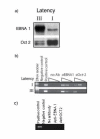Epstein-Barr virus latency switch in human B-cells: a physico-chemical model
- PMID: 17764547
- PMCID: PMC2164963
- DOI: 10.1186/1752-0509-1-40
Epstein-Barr virus latency switch in human B-cells: a physico-chemical model
Abstract
Background: The Epstein-Barr virus is widespread in all human populations and is strongly associated with human disease, ranging from infectious mononucleosis to cancer. In infected cells the virus can adopt several different latency programs, affecting the cells' behaviour. Experimental results indicate that a specific genetic switch between viral latency programs, reprograms human B-cells between proliferative and resting states. Each of these two latency programs makes use of a different viral promoter, Cp and Qp, respectively. The hypothesis tested in this study is that this genetic switch is controlled by both human and viral transcription factors; Oct-2 and EBNA-1. We build a physico-chemical model to investigate quantitatively the dynamical properties of the promoter regulation and experimentally examine protein level variations between the two latency programs.
Results: Our experimental results display significant differences in EBNA-1 and Oct-2 levels between resting and proliferating programs. With the model we identify two stable latency programs, corresponding to a resting and proliferating cell. The two programs differ in robustness and transcriptional activity. The proliferating state is markedly more stable, with a very high transcriptional activity from its viral promoter. We predict the promoter activities to be mutually exclusive in the two different programs, and our relative promoter activities correlate well with experimental data. Transitions between programs can be induced, by affecting the protein levels of our transcription factors. Simulated time scales are in line with experimental results.
Conclusion: We show that fundamental properties of the Epstein-Barr virus involvement in latent infection, with implications for tumor biology, can be modelled and understood mathematically. We conclude that EBNA-1 and Oct-2 regulation of Cp and Qp is sufficient to establish mutually exclusive expression patterns. Moreover, the modelled genetic control predict both mono- and bistable behavior and a considerable difference in transition dynamics, based on program stability and promoter activities. Both these phenomena we hope can be further investigated experimentally, to increase the understanding of this important switch. Our results also stress the importance of the little known regulation of human transcription factor Oct-2.
Figures






Similar articles
-
HCF1 and OCT2 Cooperate with EBNA1 To Enhance OriP-Dependent Transcription and Episome Maintenance of Latent Epstein-Barr Virus.J Virol. 2016 May 12;90(11):5353-5367. doi: 10.1128/JVI.00239-16. Print 2016 Jun 1. J Virol. 2016. PMID: 27009953 Free PMC article.
-
Autorepression of Epstein-Barr virus nuclear antigen 1 expression by inhibition of pre-mRNA processing.J Virol. 2008 Feb;82(4):1679-87. doi: 10.1128/JVI.02142-07. Epub 2007 Dec 12. J Virol. 2008. PMID: 18077719 Free PMC article.
-
Methylation of the EBV genome and establishment of restricted latency in low-passage EBV-infected 293 epithelial cells.Virology. 2002 Jul 20;299(1):109-21. doi: 10.1006/viro.2002.1457. Virology. 2002. PMID: 12167346
-
Epigenetic regulation of latent Epstein-Barr virus promoters.Biochim Biophys Acta. 2010 Mar-Apr;1799(3-4):228-35. doi: 10.1016/j.bbagrm.2009.10.005. Epub 2009 Oct 22. Biochim Biophys Acta. 2010. PMID: 19853674 Review.
-
Epstein-Barr virus immortalization and latency.Front Biosci. 1999 Mar 15;4:D346-71. doi: 10.2741/rowe. Front Biosci. 1999. PMID: 10077545 Review.
Cited by
-
Dynamics inside the cancer cell attractor reveal cell heterogeneity, limits of stability, and escape.Proc Natl Acad Sci U S A. 2016 Mar 8;113(10):2672-7. doi: 10.1073/pnas.1519210113. Epub 2016 Feb 29. Proc Natl Acad Sci U S A. 2016. PMID: 26929366 Free PMC article.
-
Diabetes, Epstein-Barr virus and extranodal natural killer/T-cell lymphoma in India: Unravelling the plausible nexus.Indian J Med Paediatr Oncol. 2016 Jan-Mar;37(1):6-13. doi: 10.4103/0971-5851.177002. Indian J Med Paediatr Oncol. 2016. PMID: 27051150 Free PMC article. Review.
-
Stochastic modeling of human papillomavirusearly promoter gene regulation.J Theor Biol. 2020 Feb 7;486:110057. doi: 10.1016/j.jtbi.2019.110057. Epub 2019 Oct 28. J Theor Biol. 2020. PMID: 31672406 Free PMC article.
-
Chromatin organization of gammaherpesvirus latent genomes.Biochim Biophys Acta. 2010 Mar-Apr;1799(3-4):236-45. doi: 10.1016/j.bbagrm.2009.10.004. Epub 2009 Oct 22. Biochim Biophys Acta. 2010. PMID: 19853673 Free PMC article. Review.
-
The B-cell specific transcription factor, Oct-2, promotes Epstein-Barr virus latency by inhibiting the viral immediate-early protein, BZLF1.PLoS Pathog. 2012 Feb;8(2):e1002516. doi: 10.1371/journal.ppat.1002516. Epub 2012 Feb 9. PLoS Pathog. 2012. PMID: 22346751 Free PMC article.
References
-
- Almqvist J. Epstein-Barr virus nuclear antigen 1, Oct & Groucho/TLE in control of promoter regulation. PhD thesis, Karolinska Institutet. 2005.
-
- Schaefer BC, Woisetschlager M, Strominger JL, Speck SH. Exclusive expression of Epstein-Barr virus nuclear antigen 1 in Burkitts lymphoma arises from a third promoter, distinct from the promoters used in latently infected lymphocytes. Proc Natl Acad Sci. 1991;88:6550–6554. doi: 10.1073/pnas.88.15.6550. - DOI - PMC - PubMed
Publication types
MeSH terms
Substances
LinkOut - more resources
Full Text Sources
Miscellaneous

